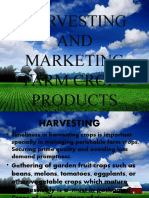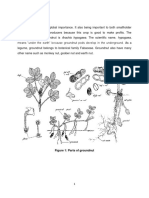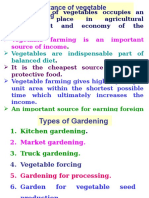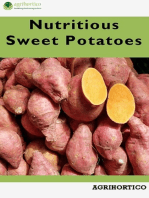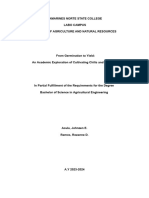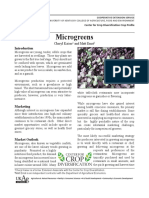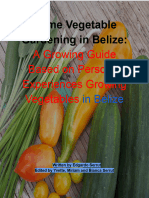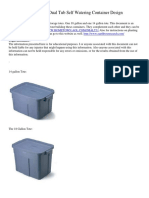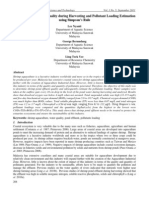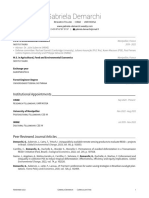0 ratings0% found this document useful (0 votes)
38 viewsProduction of Miniature Vegetables in Florida: Donald N. Maynard
Production of Miniature Vegetables in Florida: Donald N. Maynard
Uploaded by
marianaivanovaprofThis document discusses the production of miniature vegetables in Florida. It begins by defining miniature vegetables as similar to normal sized vegetables but considerably smaller, produced by early harvesting or dwarf varieties. It then discusses several vegetables well-suited for miniature production like squash, beans, carrots, beets. Production requires similar techniques to normal vegetables but with closer spacing and succession planting. Miniature vegetables command a higher price due to intensive labor and low yields. Proper post-harvest handling and storage at cool temperatures is especially important for miniature vegetable quality.
Copyright:
© All Rights Reserved
Available Formats
Download as PDF, TXT or read online from Scribd
Production of Miniature Vegetables in Florida: Donald N. Maynard
Production of Miniature Vegetables in Florida: Donald N. Maynard
Uploaded by
marianaivanovaprof0 ratings0% found this document useful (0 votes)
38 views5 pagesThis document discusses the production of miniature vegetables in Florida. It begins by defining miniature vegetables as similar to normal sized vegetables but considerably smaller, produced by early harvesting or dwarf varieties. It then discusses several vegetables well-suited for miniature production like squash, beans, carrots, beets. Production requires similar techniques to normal vegetables but with closer spacing and succession planting. Miniature vegetables command a higher price due to intensive labor and low yields. Proper post-harvest handling and storage at cool temperatures is especially important for miniature vegetable quality.
Original Description:
Mini vegetables description
Original Title
Mini Vegetables
Copyright
© © All Rights Reserved
Available Formats
PDF, TXT or read online from Scribd
Share this document
Did you find this document useful?
Is this content inappropriate?
This document discusses the production of miniature vegetables in Florida. It begins by defining miniature vegetables as similar to normal sized vegetables but considerably smaller, produced by early harvesting or dwarf varieties. It then discusses several vegetables well-suited for miniature production like squash, beans, carrots, beets. Production requires similar techniques to normal vegetables but with closer spacing and succession planting. Miniature vegetables command a higher price due to intensive labor and low yields. Proper post-harvest handling and storage at cool temperatures is especially important for miniature vegetable quality.
Copyright:
© All Rights Reserved
Available Formats
Download as PDF, TXT or read online from Scribd
Download as pdf or txt
0 ratings0% found this document useful (0 votes)
38 views5 pagesProduction of Miniature Vegetables in Florida: Donald N. Maynard
Production of Miniature Vegetables in Florida: Donald N. Maynard
Uploaded by
marianaivanovaprofThis document discusses the production of miniature vegetables in Florida. It begins by defining miniature vegetables as similar to normal sized vegetables but considerably smaller, produced by early harvesting or dwarf varieties. It then discusses several vegetables well-suited for miniature production like squash, beans, carrots, beets. Production requires similar techniques to normal vegetables but with closer spacing and succession planting. Miniature vegetables command a higher price due to intensive labor and low yields. Proper post-harvest handling and storage at cool temperatures is especially important for miniature vegetable quality.
Copyright:
© All Rights Reserved
Available Formats
Download as PDF, TXT or read online from Scribd
Download as pdf or txt
You are on page 1of 5
HS36
Production of Miniature Vegetables in Florida
1
Donald N. Maynard
2
1. This document is HS36, one of a series of the Horticultural Sciences Department, Florida Cooperative Extension Service, Institute of Food and Agricultural
Sciences, University of Florida. Original publication date January 1989. Revised September 2006. Visit the EDIS Web Site at http://edis.ifas.ufl.edu.
2. Donald N. Maynard, Professor Emeritus, Department of Horticultural Sciences, Gulf Coast Research and Education Center, Wimauma; Institute of Food
and Agricultural Sciences, University of Florida, Gainesville, 32611.
The Institute of Food and Agricultural Sciences (IFAS) is an Equal Opportunity Institution authorized to provide research, educational information and
other services only to individuals and institutions that function with non-discrimination with respect to race, creed, color, religion, age, disability, sex,
sexual orientation, marital status, national origin, political opinions or affiliations. U.S. Department of Agriculture, Cooperative Extension Service,
University of Florida, IFAS, Florida A. & M. University Cooperative Extension Program, and Boards of County Commissioners Cooperating. Larry
Arrington, Dean
Miniature or baby vegetables are similar to
normal size vegetables except they are considerably
smaller. They are produced by harvesting the product
before it has attained market size or by use of
genetically dwarf varieties.
Figure 1. Miniature squash varieties: upper center and
clockwise, 'Gold Rush', 'Zucchini Elite,' 'Supersette',
'Goldie', 'Multipik', 'Ambassador', 'Seneca Prolific',
'Classic'; upper center, 'Sunburst'; lower center,
'Starflower'. The squash in the center are about 1 inch in
diameter. Surrounding squash range from 2-3 inches in
length.
Miniature or baby vegetables are a relatively
new class of specialty vegetables. Other specialty
vegetables include those grown on small acreages,
ethnic vegetables, gourmet vegetables and organically
grown vegetables. Specialty vegetable production
offers large growers the opportunity to diversify and
small growers a chance to be competitive in the
market place.
The market for miniature vegetables is relatively
small compared to the market for most Florida
vegetables. At the present time they are used in some
of the better restaurants and are sold directly to
consumers in gourmet and specialty shops. Thus far,
chain store have not generally handled miniatures.
Quality miniature vegetables command a high
price which is justified because of the high level of
management and labor required in production and the
relatively low yields obtained because of the small
size of the harvested product. As with any new
venture, growers should thoroughly understand the
market demand and potential before planting.
Miniature Vegetables
Almost any vegetables can be grown and
marketed as miniatures. However, certain crops have
proven to be more acceptable than others. Vegetables
readily adapted to miniature production are listed in
Table 1.
Production of Miniature Vegetables in Florida 2
Other vegetables such as cabbage, cauliflower,
cucumber, lettuce, muskmelon, onion, pepper, and
watermelon may be grown as miniatures, however,
established trade has been restricted mainly to those
vegetables listed in Table 1.
Table 1. Vegetables adapted to production of miniatures
classified according to usable plant part.
Fruit Vegetative Storage Organ
French bean
Indian corn
Sweet corn
Eggplant
Pumpkin
Squash
Tomato
Beet
Carrot
Kohlrabi
Turnip
Varieties
Not all varieties are suitable for production of
miniatures, however, there are usually several choices
that can be made. The listing of some potential
varieties for production of miniature vegetables in
Table 2 is representative of those that may be
selected.
Culture of Miniature Vegetables
In general, the culture used for miniature
vegetable production is similar to that used for
general vegetable production. After suitable varieties
have been selected, plans for size of plantings and
succession plantings to ensure a continuous product
supply should be made. Some points to consider
when making planting plans are: (1) time from
planting to harvest for some miniature vegetables, e.g.
squash, beet, carrot, turnip, is shorter than that for
production of full-size vegetables; (2) the root crops
and kohlrabi are at optimum harvest size for only a
short period, so plantings should not be larger than
can be marketed while the crop is at optimum size;
(3) frequent, successive plantings of these crops will
be necessary; (4) because the size of the harvested
product is smaller, some crops may be spaced closer
together than ordinarily. In some cases, close spacing
is useful for obtaining and maintaining miniature
size.
Another point of difference between general
vegetables and miniature vegetables is that pesticides
must be chosen with care to insure that applications
are made within the stated days before harvest. With a
shorter period to harvest, some chemicals used for
general production may not be suitable for miniature
vegetable production.
Harvesting and Postharvest
Handling
There are no U.S. grade standards for miniature
vegetables, therefore, size and quality are dictated by
market demand. The product should always be as
uniform as possible, clean, free from damage, and
free from decay. Likewise, there are no standard
containers for miniature vegetables, however,
because of their size and value, they are usually
packed in relatively small baskets or cartons. Market
demand may vary somewhat, but the general
guidelines in Table 3 can be used as a starting point
for new growers of miniature vegetables.
Specific storage conditions for miniature
vegetables have not been researched. However, it is
thought that generally these vegetables are more
subject to postharvest deterioration than their
normal-size counterparts. Accordingly, it is
extremely important to cool and hold miniature
vegetables under recommended temperature and
relative humidity conditions as outlined in Table 3.
Figure 2. This display of miniature root and stem
vegetables includes turnips, beets, golden beets, white
carrots, round carrots, purple and green kohlrabi.
Production of Miniature Vegetables in Florida 3
Figure 3. These miniature eggplants are called 'Little
Fingers'. They range from 1 to 1/4-3 inches in length.
Table 2. Representative varieties for production of miniature vegetables and seed sources.
Vegetable Variety Description Seed Source
z
French bean Aiguillon haricot vert
Frenchie
Major haricot
Triumph de Farcey
Dark green pods
Dark green, round pods
Yellow, round pods
Dark green with purple streaks
5
7
5
4
Beet Avenger
Burpee's Golden
Chioggia
Dwergina
Little Ball
Little Mini Ball
Medium red, globe shaped
Gold colored roots
Concentric red and white rings
Genetically dwarf type
Round, dwarf type
Round, dwarf type
3
2,5,7
5
4,5
2
7
Carrot Amca
Amstel
Baby Sweet Hybrid
Little Finger
Minicor
Wita Sweet #500
French type
French type
F
1
hybrid, bright orange
Cylindrical, small core
Amsterdam forcing type
F
1
hybrid
1,8
6
7
2
4,5,7
1,8
Indian corn Cutie Pops
Indian Fingers
Papoose
Strawberry
Symphonie
Multicolored ears
Multicolored ears
Multicolored ears
Mahogany red, round ears
Multicolored ears
7
3,5
8
2,3
7
Sweet corn Baby Asian
Golden Midget
Harvest at silking
Normal sweet corn maturity
5
6
Eggplant Easter Egg
Little Fingers
White, oval fruit purple, elongated fruit 8
3
Kohlrabi Early Purple Vienna
Grand Duke
Purple colored
F
1
hybrid, light green colored
2,7
1,2,3,6,7,8
Pumpkin Jack-Be-Little
Munchkin
Sweetie Pie
True pumpkin, 3-4 oz
True pumpkin, 3-4 oz
True pumpkin, 3-4 oz
3
7
Production of Miniature Vegetables in Florida 4
Table 2. Representative varieties for production of miniature vegetables and seed sources.
Vegetable Variety Description Seed Source
z
Squash Gourmet Globe
Jersey Golden
Multipik
Sunburst
Supersette
Zucchini Elite
Round, green fruit
Gold acorn type
F
1
hybrid, yellow straightneck type
F
1
hybrid, yellow scallop type
F
1
hybrid, yellow crookneck type
F
1
hybrid, dark green
6,8
1,2,4,5,6,8
3
1,2,3,4,5,6,8
3
3
Turnip Purple Top White Globe
Tokyo Cross
Purple crown with white below
F
1
hybrid, white root
2,3,4,6,7,8
1,2,6,7,8
Tomato Red Pear
Yellow Cherry
Yellow Pear
Red, pear-shaped fruit
Yellow, round fruit
Yellow, pear-shaped fruit
7
7
2,3,5,7
z
1. Abbot & Cobb, Inc., P.O. Box 307, Feasterville, PA 19074
2. W. Atlee Burpee Co., 300 Park Ave., Warminster, PA 18991
3. Harris Seed Co., 3670 Buffalo Rd., Rochester, Ny 14624
4. Johnny's Selected Seeds, 955 Benton Ave., Winslow, ME 04901
5. Le Marche Seeds International, P.O. box 190, Dixon, CA 95620
6. Geo. W. Park Co., Inc., Cokesbury Rd., Greeenwood, SC 29646
7. Stokes Seeds Inc., P.O. Box 548, Buffalo, NY 14240
8. Twilley Seed Co., Inc., 121 Gary Road, Hodges, SC 29653
Table 3. Harvesting and packing guidelines and storage conditions for miniature vegetables.
Vegetable Harvesting and Packing Suggestions
Storage Conditions
Temperature (F) Relative
Humidity (%)
French
bean
Harvest when beans have attained full length, but before seed
enlargement. Beans are usually place packed in one or two
rows depending upon container configuration. Sold by weight.
44-48 95
Beet Harvest when beets are 0.5 to 1 inch in diameter. Bunches of
about six beets are packed with the tops in cartons containing
12 bunches.
32 98-100
Carrot Harvest when carrots are 3 to 4 inches long. Bunches of about
six roots are packed with the tops in cartons containing 12
bunches.
32 98-100
Indian corn Ears are allowed to mature on the stalk. Additional drying may
be necessary after harvest. Husks are pulled back. Packed
singly or bunched.
Ambient 50
Sweet corn Baby Asian is harvested at silking when ears are 2 to 3 inches
long. Usually sold by count in the husk. Golden Midget is
harvested at normal market maturity.
32 95-98
Eggplant Harvested when fruit are 1.5 to 3 inches long. Packed in baskets
or cartons
50-55 90-95
Production of Miniature Vegetables in Florida 5
Table 3. Harvesting and packing guidelines and storage conditions for miniature vegetables.
Vegetable Harvesting and Packing Suggestions
Storage Conditions
Temperature (F) Relative
Humidity (%)
Kohlrabi Harvested when stems are 1 to 1.5 inches in diameter. Crown
leaves are retained. Packed in baskets or cartons.
32 98-100
Pumpkin Harvested when fully mature. Packed in cartons or wirebound
crates.
50-55 50-70
Squash Harvested before or when blossom opens. Some markets
prefer blossoms attached. Fruit with blossoms are very
perishable. Packed in cartons.
44-50 95
Turnip Harvested when roots are about 1 inch in diameter. One dozen
bunches of about six roots are packed to the carton.
32 98-100
Tomato Harvest when fruit are turning but not fully colored. Packed in
pint containers, 12 to the flat.
45-50 90-95
You might also like
- DPR Ksidc 2492015 PDFDocument202 pagesDPR Ksidc 2492015 PDFpravass100% (4)
- Market Research On WatermelonDocument7 pagesMarket Research On WatermelonMichelle sorianoNo ratings yet
- OlericultureDocument30 pagesOlericultureNoah Sparks100% (1)
- C1 Kurs-Und Ubungsbuch LosungenDocument35 pagesC1 Kurs-Und Ubungsbuch LosungenmarianaivanovaprofNo ratings yet
- Eswara Reddy-Kitchen GardenDocument38 pagesEswara Reddy-Kitchen GardenDr.Eswara Reddy Siddareddy100% (6)
- Kitchen Garden Lay OutDocument24 pagesKitchen Garden Lay OutDr.Eswara Reddy SiddareddyNo ratings yet
- How To Grow Micro GreensDocument3 pagesHow To Grow Micro Greenspwilkers3650% (2)
- HELE Grade 5-2nd QuarterDocument4 pagesHELE Grade 5-2nd QuarterNanay Gi100% (3)
- Organic PotatoesDocument9 pagesOrganic PotatoesFernando Morote IbarrolaNo ratings yet
- Group 6Document7 pagesGroup 6JAY MARIE PRESBITERONo ratings yet
- Final Cookery12 Q2 Module 2Document18 pagesFinal Cookery12 Q2 Module 2Junah SumalinogNo ratings yet
- Seed Saving Guidelines CompleteDocument46 pagesSeed Saving Guidelines Completewashboard101100% (4)
- Cultural PracticesDocument3 pagesCultural PracticesrexazarconNo ratings yet
- Thesis About Sweet PepperDocument5 pagesThesis About Sweet Peppersunshineblackburnhayward100% (2)
- Culinary Herbs by University of KentuckyDocument4 pagesCulinary Herbs by University of KentuckyAnonymous HXLczq3No ratings yet
- Test 8Document14 pagesTest 8annieduong999No ratings yet
- Growing Cucumbers, Peppers, Squash and Tomatoes in Containers, HYG-1645-94Document4 pagesGrowing Cucumbers, Peppers, Squash and Tomatoes in Containers, HYG-1645-94tangeloxadeNo ratings yet
- Vegetable Farming in Nigeria PDFDocument18 pagesVegetable Farming in Nigeria PDFDamorock100% (1)
- Terrace Vegetable GardeningDocument12 pagesTerrace Vegetable GardeningJohnson JohnNo ratings yet
- Harvesting AND Marketing Farm Crops ProductsDocument58 pagesHarvesting AND Marketing Farm Crops ProductsRose Ann M. NugaNo ratings yet
- Introduction Until Propagation Report AGR 302 GroundnutsDocument7 pagesIntroduction Until Propagation Report AGR 302 GroundnutsMark SullivanNo ratings yet
- Literature Review of French BeansDocument5 pagesLiterature Review of French Beansgw13qds8100% (1)
- Potato Growing PotatoesDocument3 pagesPotato Growing PotatoesVijay IyerNo ratings yet
- Importance of Vegetable Farming: Important Place in Agricultural Development and Economy of The CountryDocument18 pagesImportance of Vegetable Farming: Important Place in Agricultural Development and Economy of The CountryKareen Carlos GerminianoNo ratings yet
- Breeding Tomatoes OSA 1 1Document20 pagesBreeding Tomatoes OSA 1 1Max MNo ratings yet
- Module 1. (9pp) Basic Concepts in HorticultureDocument8 pagesModule 1. (9pp) Basic Concepts in HorticultureDimasalang Perez100% (3)
- Gardening - Planning The GardenDocument4 pagesGardening - Planning The Gardencontadino_impazzitoNo ratings yet
- Sweet Some ThingsDocument6 pagesSweet Some ThingslastoutriderNo ratings yet
- Talong and Sili Production.Document10 pagesTalong and Sili Production.empleogabrielle85No ratings yet
- The Fresh Girl's Guide to Easy Canning and PreservingFrom EverandThe Fresh Girl's Guide to Easy Canning and PreservingRating: 4 out of 5 stars4/5 (2)
- SUBSTITUTESDocument4 pagesSUBSTITUTESShiena Kate LastimosaNo ratings yet
- Tle 10 q2 Week 1-2Document8 pagesTle 10 q2 Week 1-2Joebell PadillaNo ratings yet
- Productionguide OnionDocument11 pagesProductionguide OnionJonas Reduta Cabacungan0% (1)
- V9 Radovich SeedsaveDocument6 pagesV9 Radovich Seedsavemsbarcio4433No ratings yet
- Potentially Important Food Plants of BangladeshDocument71 pagesPotentially Important Food Plants of Bangladeshhanzo1260No ratings yet
- Mhys Thesis Final Nagid NiDocument32 pagesMhys Thesis Final Nagid NiEya Alaro83% (6)
- Vegetable Hybrid Seed ProductionDocument12 pagesVegetable Hybrid Seed ProductionZakriya AlviNo ratings yet
- Module 1. Basic Concepts in Horticulture PDFDocument18 pagesModule 1. Basic Concepts in Horticulture PDFagnes rodriguez100% (1)
- Liberia Field Guide V2Document68 pagesLiberia Field Guide V2gmlp.2298No ratings yet
- Green TomaDocument4 pagesGreen TomaFarhat Abbas DurraniNo ratings yet
- QUARTER 1 Module 1. Basic Concepts in HorticultureDocument18 pagesQUARTER 1 Module 1. Basic Concepts in HorticultureApple Joyce EstrellaNo ratings yet
- Dragon Fruit Growing and Production: Health BenefitsDocument4 pagesDragon Fruit Growing and Production: Health BenefitsEarnswell Pacina Tan0% (1)
- Peanuts PDFDocument4 pagesPeanuts PDFWahyuningsih HamidNo ratings yet
- Glen William Greenhouses LTDDocument9 pagesGlen William Greenhouses LTDyuniartiNo ratings yet
- Microgreens: Cheryl Kaiser and Matt ErnstDocument3 pagesMicrogreens: Cheryl Kaiser and Matt Ernstghonamy100% (1)
- Deboral ProjectDocument16 pagesDeboral ProjectAFENI ADEOYENo ratings yet
- TLE 10-Cookery - Q2 - W1-2 - M1 - LDS - Principles-of-Preparing-Vegetables - JRA-RTPDocument7 pagesTLE 10-Cookery - Q2 - W1-2 - M1 - LDS - Principles-of-Preparing-Vegetables - JRA-RTPEDMARK PONCENo ratings yet
- Green Fingers Organic FarmsDocument17 pagesGreen Fingers Organic FarmsajdeclandNo ratings yet
- Micro GreensDocument3 pagesMicro GreensHeemanshu Shah0% (1)
- Home Vegetable Gardening in Belize-UpdatedDocument19 pagesHome Vegetable Gardening in Belize-UpdatedEdgardo SerrutNo ratings yet
- A Do-It-Yourself Vegetable Gardening Guide for Beginners: A Beginner's Guide to Growing Organic Vegetables and Raising Fish with Aquaponic GardeningFrom EverandA Do-It-Yourself Vegetable Gardening Guide for Beginners: A Beginner's Guide to Growing Organic Vegetables and Raising Fish with Aquaponic GardeningRating: 5 out of 5 stars5/5 (1)
- Growing Peppers in Home Gardens June 23 DraftDocument11 pagesGrowing Peppers in Home Gardens June 23 DraftMohamed ParkerNo ratings yet
- How To Hydro and GrowingDocument12 pagesHow To Hydro and GrowingChris KellerNo ratings yet
- HORT 200a.manus Outline - ZafraDocument27 pagesHORT 200a.manus Outline - ZafraShadd ZafraNo ratings yet
- Home Gardening: Bob Westerfield UGA Extension HorticulturistDocument20 pagesHome Gardening: Bob Westerfield UGA Extension HorticulturistKandice LedfordNo ratings yet
- The Potato - With Information on Varieties, Seed Selection, Cultivation and Diseases of the PotatoFrom EverandThe Potato - With Information on Varieties, Seed Selection, Cultivation and Diseases of the PotatoNo ratings yet
- ProdguidebeetrootDocument16 pagesProdguidebeetrootmarianaivanovaprofNo ratings yet
- NutritionManuals References FinalDocument19 pagesNutritionManuals References FinalmarianaivanovaprofNo ratings yet
- Beets: Agriculture and Natural ResourcesDocument3 pagesBeets: Agriculture and Natural ResourcesmarianaivanovaprofNo ratings yet
- APA2013 Book of AbstractsDocument210 pagesAPA2013 Book of Abstractsmarianaivanovaprof100% (1)
- Farm Field Day EvaluationDocument1 pageFarm Field Day EvaluationmarianaivanovaprofNo ratings yet
- I'm Good at ReadingDocument11 pagesI'm Good at ReadingmarianaivanovaprofNo ratings yet
- Sem in Is Tomato Disease GuideDocument81 pagesSem in Is Tomato Disease GuidemarianaivanovaprofNo ratings yet
- Plant Sample For Plant AnalysisDocument6 pagesPlant Sample For Plant Analysismarianaivanovaprof100% (1)
- Booklet Yellow and Orange FoodreportDocument65 pagesBooklet Yellow and Orange FoodreportmarianaivanovaprofNo ratings yet
- Edible Veg OilsDocument12 pagesEdible Veg OilsmarianaivanovaprofNo ratings yet
- ASEAN Manual of Food AnalysisDocument196 pagesASEAN Manual of Food Analysisaria1354100% (2)
- Beet & Beetroot: Detroit Dark RedDocument77 pagesBeet & Beetroot: Detroit Dark RedmarianaivanovaprofNo ratings yet
- Bitter GourdDocument7 pagesBitter GourdmarianaivanovaprofNo ratings yet
- Agrarian SocietiesDocument3 pagesAgrarian SocietiesRaisa GeleraNo ratings yet
- Controlled Environmental Farming Inc. Business Plan Carlton, MinnesotaDocument13 pagesControlled Environmental Farming Inc. Business Plan Carlton, MinnesotaSamuel PolontaloNo ratings yet
- Contract Farming Models - DelhiDocument39 pagesContract Farming Models - Delhiapi-3833893100% (1)
- Bitter Kola Nut and Edulis Trees Production To ConsumptionDocument125 pagesBitter Kola Nut and Edulis Trees Production To ConsumptionAtty Atty100% (1)
- BellpepperDocument12 pagesBellpepperJojit BalodNo ratings yet
- Report - Millets 2022 (Print Version)Document44 pagesReport - Millets 2022 (Print Version)KeertNo ratings yet
- Marigold VarietiesDocument1 pageMarigold VarietiesDrRuby Ranjan SharmaNo ratings yet
- Types of ErosionDocument22 pagesTypes of Erosionmuhammad_ajmal_25No ratings yet
- Sericulture BooksDocument29 pagesSericulture BooksHARIS KKNo ratings yet
- Appsc Group 1 SyllabusDocument22 pagesAppsc Group 1 SyllabusBvh ShankarNo ratings yet
- The Dual Tub Self Watering Container Design: Legal DisclaimerDocument11 pagesThe Dual Tub Self Watering Container Design: Legal DisclaimerjlpicardNo ratings yet
- UntitledDocument12 pagesUntitledaviNo ratings yet
- Economic and Environmental Concerns in Philippine Upland Coconut Farms - An Analysis of Policy, Farming Systems and Socio Economic IssuesDocument64 pagesEconomic and Environmental Concerns in Philippine Upland Coconut Farms - An Analysis of Policy, Farming Systems and Socio Economic IssuesPogpog ReyesNo ratings yet
- Research Proposal On Global Warming Impacts On PakistanDocument13 pagesResearch Proposal On Global Warming Impacts On PakistanAhsan RiazNo ratings yet
- A List of Forage Grasses and Scoentific NameDocument5 pagesA List of Forage Grasses and Scoentific NameXz Rivera67% (3)
- Marketing California LettuceDocument2 pagesMarketing California LettuceLiezle MhariaNo ratings yet
- Shrimp Pond Effluent Quality During Harvesting and Pollutant Loading Estimation Using Simpson's RuleDocument6 pagesShrimp Pond Effluent Quality During Harvesting and Pollutant Loading Estimation Using Simpson's RuleGeorge Anak BerundangNo ratings yet
- The Adoptionand Inhibitionof Robotics Technologyinthe PhilippinesDocument10 pagesThe Adoptionand Inhibitionof Robotics Technologyinthe PhilippinesMaxNo ratings yet
- 4th Monthly KinderDocument10 pages4th Monthly KinderJobert BartolayNo ratings yet
- How To Write A Research IntroductionDocument12 pagesHow To Write A Research IntroductionJoannaCay GarciaNo ratings yet
- Report For Import Raw CottonDocument8 pagesReport For Import Raw CottonMd. Saiful IslamNo ratings yet
- The Feasibility of Mango Leaves As An Organic FertilizerDocument3 pagesThe Feasibility of Mango Leaves As An Organic FertilizerLawrence Andrei CamachoNo ratings yet
- ITC Report and Accounts 2023Document414 pagesITC Report and Accounts 2023Nishith RanjanNo ratings yet
- Gly Star Plus H LabelDocument72 pagesGly Star Plus H LabelDEVESH BHOLENo ratings yet
- Alternative Agriculture in Thailand and JapanDocument15 pagesAlternative Agriculture in Thailand and Japananakin_sNo ratings yet
- Chapter 3 Water Resources Q & AnsDocument4 pagesChapter 3 Water Resources Q & AnsShubham MishraNo ratings yet
- Discuss The Interactions Between S&T and Society Throughout History Discuss How Scientific and Technological Developments Affect Society and The EnvironmentDocument4 pagesDiscuss The Interactions Between S&T and Society Throughout History Discuss How Scientific and Technological Developments Affect Society and The EnvironmentJhona AregloNo ratings yet
- CV Demarchi Nov23Document2 pagesCV Demarchi Nov23api-613799982No ratings yet



















